Researchers did a groundbreaking study. They scanned the brains of Franciscan nuns, Buddhist monks, and Sikhs while they prayed, meditated, or chanted1. This study showed how religious practices change the human brain. It’s part of a new field called neurotheology, which looks at how our brains and religion are connected2.
Neurotheology is a mix of theology, religious studies, cognitive science, neuroscience, psychology, and anthropology2. Researchers use brain scans to learn about spiritual experiences and how religion changes the brain1. This helps us understand the link between our brains and our spiritual feelings1.
Andrew Newberg, the director of research at Thomas Jefferson University Hospital, has greatly helped this field3. His book, “Neurotheology,” talks about how neuroscience and religion connect3. It’s a detailed book with 328 pages, available in paperback, hardcover, and e-book3.
Key Takeaways
- Neurotheology is a new field that looks at how our brains and religion are linked.
- Researchers use brain scans to see how religion affects the brain.
- This field combines theology, neuroscience, and psychology.
- It aims to connect science and spirituality by studying the brain and religion.
- Andrew Newberg’s book “Neurotheology” offers deep insights into this field.
Introduction to Neurotheology
Neurotheology is a new field that looks at how the brain and religious experiences are connected. It mixes neuroscientific research with theology and philosophy. This helps us understand the brain’s role in spirituality4. By linking science and religion, neurotheology gives us a new way to see how our minds and spirits work together4.
Definition of Neurotheology
Neurotheology aims to learn about the brain’s role in spiritual feelings like awe and connection with something greater. It uses science, psychology, and anthropology to study how the brain handles religious beliefs and experiences4. By looking at how the brain supports spirituality, neurotheology tries to understand the link between our brain and religious feelings.
Experts in neurotheology think our brain’s design might make us more likely to believe in a higher power. The limbic system, which deals with emotions, is key in this5. Studies using MRI scans show changes in the brain during religious meditation, hinting at a deep need for belief5.
The Intersection of Neuroscience and Theology
Neurotheology is where science and theology meet, needing a big effort to combine these fields4. For it to be a real field, it must connect with different religious traditions and practices. This helps us understand how our brains process religious experiences in various faiths.
| Neuroscience | Theology |
|---|---|
| Study of the brain and nervous system | Study of the nature of God and religious beliefs |
| Focuses on the biological basis of behavior and cognition | Explores questions of faith, spirituality, and the human soul |
| Utilizes scientific methods and empirical evidence | Relies on religious texts, traditions, and philosophical reasoning |
Neurotheology brings together science and spirituality in a new way. It looks at how science can help us understand religious experiences and how religious views can help us understand brain data4. This mix offers a deeper look at how our minds, brains, and spirits connect.
Neurotheology presents an integrated approach that could lead to a fuller understanding of deep existential questions and the nature of human spirituality.
As neurotheology grows, it could reveal more about how our brains support religious experiences. By being open and scientific, neurotheology can help us understand ourselves better. It bridges the gap between science and religion, seeking knowledge and understanding4.
The History of Neurotheology
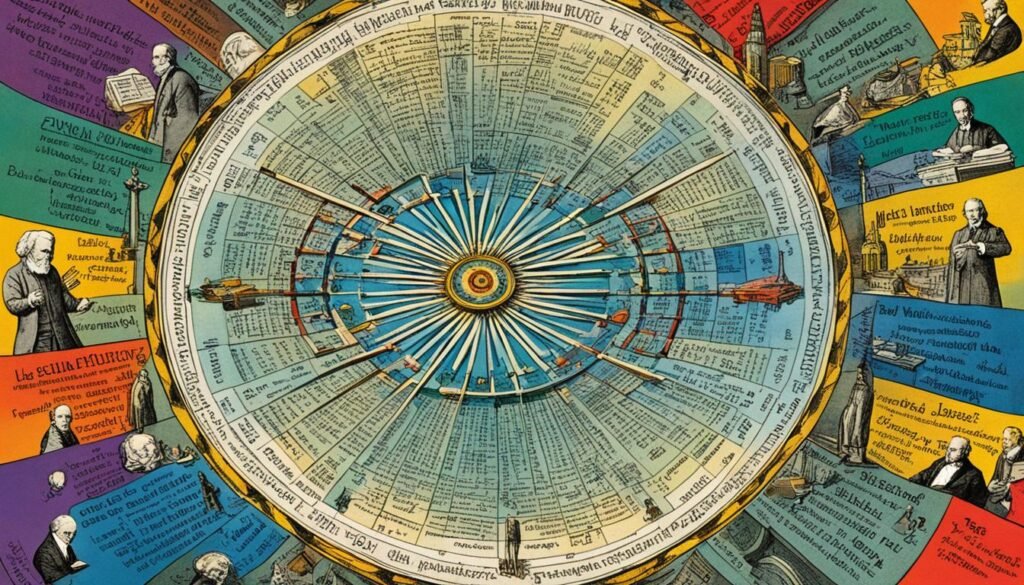
The study of how our brains connect with religious experiences is both deep and interesting. Dr. Andrew Newberg coined the term “neurotheology” in his book “Principles of Neurotheology”6. This field looks at the link between the brain and religious feelings. It has a long history.
Early Explorations of the Brain and Religion
Research into neurotheology started in the 1970s and 1980s7. Since then, scientists have looked for specific brain areas linked to religious or mystical feelings7. This early work helped shape neurotheology into what it is today.
The Work of William James
William James was a key figure in studying how the brain relates to religious experiences. His book, “The Varieties of Religious Experience,” from 1902, showed how these experiences deeply affect us. He believed these experiences have a biological basis.
“Our normal waking consciousness, rational consciousness as we call it, is but one special type of consciousness, whilst all about it, parted from it by the filmiest of screens, there lie potential forms of consciousness entirely different.” – William James, The Varieties of Religious Experience
Modern Developments in Neurotheology
In the latter half of the 20th century, scientists used new brain imaging to study religious experiences. Michael Persinger and Vilayanur Ramachandran found a link between religious feelings and the temporal lobe7. D’Aquili and Andrew Newberg created a model for religious experiences that involves the whole brain7.
The 1990s were a big time for studying the brain with machines6. This led to more interest in neurotheology. Researchers could now study how the brain works, including its role in forming who we are7.
Today, neurotheology keeps growing. Researchers aim to show how both neurology and theology see us as whole beings7. This field could help connect science and spirituality, giving us new insights into religious experiences and the brain’s role in them.
Brain Imaging Techniques in Neurotheology
Brain imaging tools like SPECT, PET, and fMRI have changed how we see the link between the brain and spirituality. These methods let researchers look into the brains of people during deep spiritual activities. This gives us new insights into how our brains work during spiritual moments8.
A study by Dr. Andrew Newberg and his team at the University of Pennsylvania found something interesting. Meditators showed more activity in the frontal lobe while meditating8. After 8 weeks of meditating for 12 minutes a day, their brains changed a lot. They got better at focusing and paying attention8. These changes led to a 10-15% boost in cognitive skills8.
Over the last three decades, brain imaging and cognitive science have made neurotheology more popular9. This field combines neuroscience, psychology, anthropology, and medicine to understand how the brain affects spirituality9. Studies show that practices like meditation, yoga, and prayer are good for our health. They help with mental health, coping, mood, and even our immune system9.
These practices also change our genes, showing how deeply they affect our health9.
Using advanced tools like PET and SPECT scans, researchers can see how spiritual activities affect our health9. This knowledge could help make spiritual practices even more beneficial for us9. The goal is to find the best practices for different health issues9.
Practicing religion or spirituality uses many parts of the brain, like language and emotions9. Studies show that these activities engage areas like the motor, limbic, and language centers. This helps us understand how our brain and body work together9. By studying meditators, researchers can learn more about how our brains focus, which could help with ADHD9.
| Brain Imaging Technique | Description | Applications in Neurotheology |
|---|---|---|
| SPECT | Single-photon emission computed tomography | Studying brain activity during spiritual practices |
| PET | Positron emission tomography | Investigating the neural correlates of religious experiences |
| fMRI | Functional magnetic resonance imaging | Examining brain changes associated with meditation and prayer |
But, we need to be careful with neurotheology. The accuracy of fMRI technology is questioned due to technical issues10. False positives in fMRI can make us doubt the results of many studies10. Researchers might also assume spiritual experiences are just brain tricks, which isn’t always true10.
As neurotheology grows, it’s important for researchers to be open-minded and careful. They should respect the complexity of the brain and the mystery of spiritual experiences.
The Effects of Religious Practices on the Brain
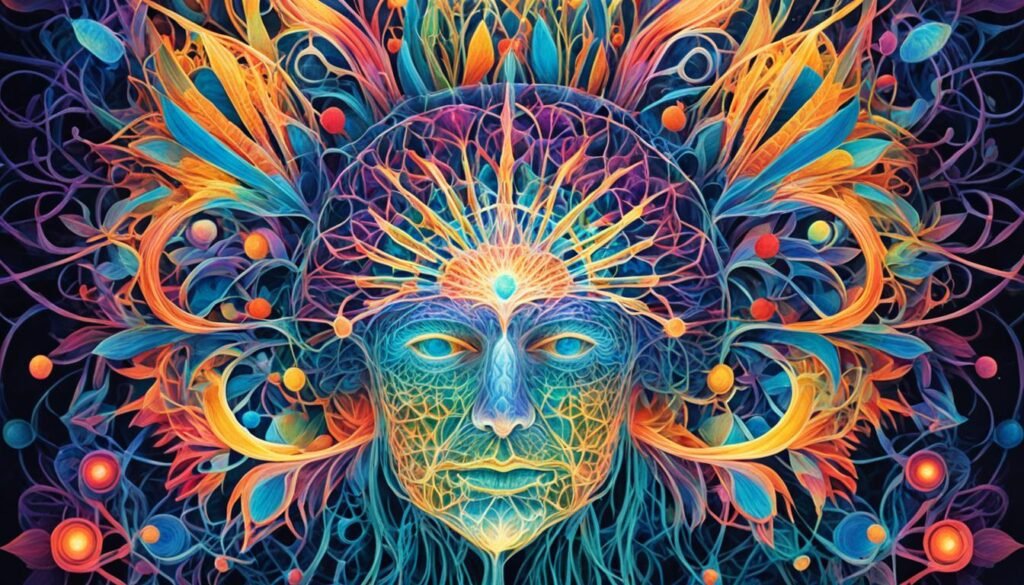
Neurotheology has shown us how deeply religious practices change the human brain. Through advanced brain scans and detailed studies, we’ve learned how prayer, meditation, and other spiritual acts change brain function and structure. These changes lead to big shifts in areas of the brain linked to focus, concentration, and managing emotions.
Prayer and Meditation
Studies show that meditators, like Tibetan Buddhists, get more activity in the frontal lobe when they meditate8. This area is key for staying focused, paying attention, and planning. Even older people with memory issues who meditated showed similar changes8.
After just 12 minutes of mantra meditation each day for eight weeks, people noticed big changes in their brains8. They said they thought clearer and remembered better, with up to 15 percent improvement8.
But, prayer and meditation affect the brain differently across religions. While meditating Buddhists and praying Catholic nuns boost frontal lobe activity, Islamic prayer lowers it. This is because it focuses on giving up control to God11.
Chanting and Rituals
Practices like chanting and rituals change brain chemistry for the better. They increase serotonin, the “happiness” chemical, and release endorphins, making people feel happy11. A study on young Mormons found that deep spiritual feelings activate brain areas linked to pleasure and rewards, similar to what happens with sex or drugs11.
Long-Term Impact of Religious Practices
Long-term religious and spiritual activities can lead to even bigger brain changes8. A study on depression risk found that believing in religion can lower the chance of getting or coming back down with depression12. An MRI study on kids and grandkids of those in the first study showed that believing in religion meant less brain thinning, a sign of depression risk12.
“Neurotheology helps us understand religious experiences better without proving or disproving a higher power. We must look at the data with an open mind, considering both the science and the spirituality.”8
Neurotheology has made big strides in understanding spiritual experiences, but individual experiences vary. Methods like meditation, chanting, and psychedelics have long been used for religious experiences. Studying these could lead to better ways to enhance their effects11.
| Religious Practice | Brain Region Affected | Effects on the Brain |
|---|---|---|
| Buddhist Meditation | Frontal Lobe | Increased activity, improved focus and attention |
| Catholic Prayer | Frontal Lobe | Increased activity, enhanced planning skills |
| Islamic Prayer | Prefrontal Cortex, Frontal Lobes | Reduced activity, decreased executive control and decision-making |
| Chanting and Rituals | Nucleus Accumbens | Increased activity, heightened pleasure and reward processing |
Exploring the link between the brain and religious experiences is crucial. We need to work together, combining neuroscience, theology, and other fields. This way, we can fully understand how spiritual practices shape our minds and improve our mental health and well-being.
Neurotheology and Consciousness Studies
Neurotheology is a new field that looks at how the brain and religious experiences are connected. It helps us understand consciousness better. By studying how spiritual practices work in the brain, researchers aim to link science and spirituality. This helps us see how our minds and brains shape our view of the world and ourselves.
Religious Experiences and Altered States of Consciousness
Religious experiences often take us to new states of mind, like mystical or numinous experiences. These states can teach us a lot about how our minds work. Studies show that meditation and prayer can make us think better, reduce stress, and help with anxiety and depression13.
Praying or meditating can change the brain, making certain areas more active13. It can also change our heart rate and blood pressure, showing how our nervous system reacts14.
Some spiritual activities can change the levels of certain brain chemicals, like dopamine and serotonin13. These changes can affect how we think and feel. They show how deeply spirituality can impact our mental health.
The Mind-Brain Relationship
Neurotheology makes us think differently about how our minds and brains work together. Some believe consciousness comes from brain activity, while others think the mind goes beyond the brain. Studies show that being spiritual can make us less likely to feel depressed or anxious13.
This suggests that spirituality can make us feel more purposeful and hopeful, which is good for our health13.
The mind-brain relationship is complex and needs a complete understanding. It involves both the brain’s workings and our personal experiences of consciousness.
Changes in the brain from spiritual practices have been seen using tools like EEG and MEG14. Other methods like PET, SPECT, and fMRI help us study spiritual experiences too14. These tools help us learn more about how our brains work during spiritual moments.
By combining science, psychology, and theology, neurotheology can change how we see consciousness and the role of religion in our lives. As research grows, it will give us new insights into how our minds and brains work together. This could help us understand reality and our place in it better.
The Holistic Function of the Brain in Neurotheology

The right hemisphere of the brain is amazing at seeing and understanding whole ideas. This helps us grasp how everything is connected. This is key in neurotheology, where it helps us see the unity in all things15.
From a neurotheological view, the brain’s ability to see the whole helps us broaden our beliefs. It lets us see the connection between us, other cultures, animals, and the universe16. As we learn more about the universe, our ideas about God have changed to fit this bigger picture.
“The holistic function of the brain enables us to perceive the divine in all things, from the smallest atom to the grandest galaxy.” – Dr. Andrew Newberg, neuroscientist and author of “Principles of Neurotheology”
Research shows that religious experiences use many parts of the brain, not just one16. During spiritual activities like meditation, the brain brings together different parts of our experience into a single whole16.
| Brain Region | Function in Holistic Perception |
|---|---|
| Right Hemisphere | Processes holistic, non-verbal, and intuitive information |
| Frontal Lobes | Involved in higher-order cognitive functions, such as reasoning and decision-making |
| Limbic System | Regulates emotional responses and plays a role in memory formation |
| Parietal Lobe | Integrates sensory information and contributes to spatial awareness |
The holistic operator is a key part of the brain in neurotheology15. It helps us see beyond simple yes or no answers. This lets us see everything as connected.
Neurotheology looks into how the brain supports religious ideas like forgiveness and love15. By understanding this, we see how our brains help shape our spiritual experiences. This shows us the deep impact of seeing the whole on our view of the divine and our place in the universe.
The Quantitative Function of the Brain in Neurotheology
The human brain is key in making math and comparing the world around us17. This helps us understand and study the universe in a methodical way. In neurotheology, how the brain works with numbers is important for understanding religious experiences.
The Significance of Numbers in Religious Traditions
Many faiths focus on special numbers and use them in symbolism17. These numbers might mean more to our brains, making us believe in their related ideas. For instance, in Christianity, three stands for the Holy Trinity, and in Islam, 99 is for Allah’s names.
“Geometry existed before the creation. It is co-eternal with the mind of God… Geometry provided God with a model for the Creation.”
– Johannes Kepler
Philosophers like Pythagoras linked math to God and the universe17. This shows how our brain’s math skills connect to our view of the divine.
The Brain’s Processing of Quantitative Concepts
Research in neurotheology shows that different faiths affect the brain in different ways17. The brain uses many areas to handle math and spiritual ideas, like the default mode network and Theory of Mind network17.
Studying meditation and spirituality in the brain is key in neurotheology18. This field aims to understand how our brain sees and experiences faith18.
| Religious Tradition | Sacred Number | Significance |
|---|---|---|
| Christianity | 3 | Represents the Holy Trinity |
| Islam | 99 | Represents the names of Allah |
| Judaism | 7 | Represents completeness and perfection |
| Hinduism | 108 | Represents the universe and spiritual completion |
Neurotheology is growing, with more research now19. We’ll learn more about how the brain works with numbers and faith. This will help connect science and theology, showing how our brain and faith are linked1819.
The Binary Function of the Brain in Neurotheology
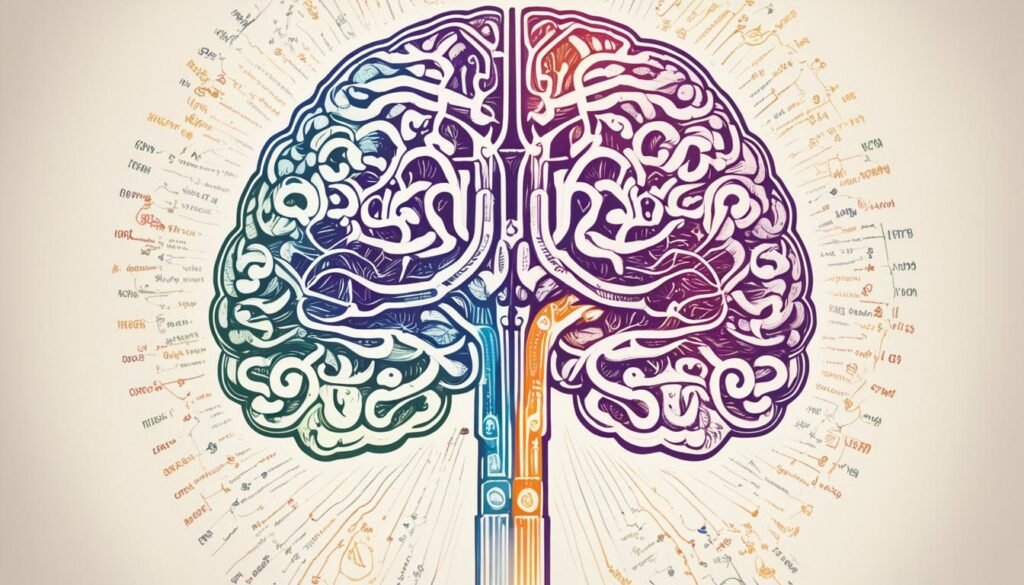
The brain’s binary function is key in neurotheology. It helps us see and tell apart good from evil, right from wrong, and humans from God. This skill is vital for grasping religious teachings, which often focus on these contrasts20.
In my study of neurotheology, I found the brain’s binary process crucial in religion. It connects humans with God20. This field combines neuroscience, medicine, neuroimaging, psychology, and anthropology. It helps us understand how the brain relates to religious feelings21.
Opposites in Religious Doctrines
Many religious texts talk about opposites like good vs. evil and right vs. wrong. These contrasts pose deep questions that religions try to answer. About 62.8% of people felt more spiritually connected after learning about neurotheology21.
“The binary brain process is fundamental in religion, helping to distinguish good from bad or right from wrong and bridging the gap between human beings and God.”20
The Brain’s Perception of Dichotomies
Our brains are wired to see and process contrasts. This helps us grasp religious ideas and feelings. Studies show the brain has many functions linked to faith and spirituality20.
The brain’s binary function lets us spot differences, like between good and evil. This is key for judging religious teachings and their solutions to life’s problems. By understanding how the brain sees contrasts, we learn more about religious experiences and their effects on us.
As neurotheology grows, with 73.5% of people feeling better after exploring it21, the study of the brain’s binary function stays vital. It bridges science and spirituality, offering new insights into the brain and faith. This helps us understand ourselves better.
The Causal Function of the Brain in Neurotheology
The human brain helps us understand and see causality, which shapes our beliefs and experiences in religion. Looking into how neuroscience and theology connect, we see the brain’s causal processes lead us to wonder about the ultimate cause of everything.
This question matches the idea of “St. Thomas Aquinas’s Uncaused First Cause,” a strong argument for God’s existence22. D’Aquili and Newberg suggest a causal operator is key in the mind’s workings23. Monotheistic faiths believe God is the uncaused cause of all, sparking debate among scholars and scientists.
Thinking about an uncaused cause is hard for us. Our brains look for causes, making it tough to grasp something without a cause. This bias affects how we see the divine and reality in neurotheology.
Research in neurotheology shows how the brain’s causal function links to religious beliefs. Studies highlight the hippocampus’s role in causal thinking and memory. A study on 268 people over 58 found more hippocampal shrinkage in those who had a life-changing religious event24.
The question of how something can be uncaused is a perplexing problem for human thought, and has been a subject of debate among theologians, philosophers, and scientists.
Linking brain findings to religion is hard24, but neurotheology keeps exploring their connection. Understanding the uncaused first cause and its impact on God and reality needs an interdisciplinary approach22.
Andrew Newberg’s dialogic model of neurotheology helps us better grasp how the brain shapes religious beliefs22. This method deepens our knowledge of the mind and brain, aiding in the study of science and spirituality.
Neurotheology and the Nature of God
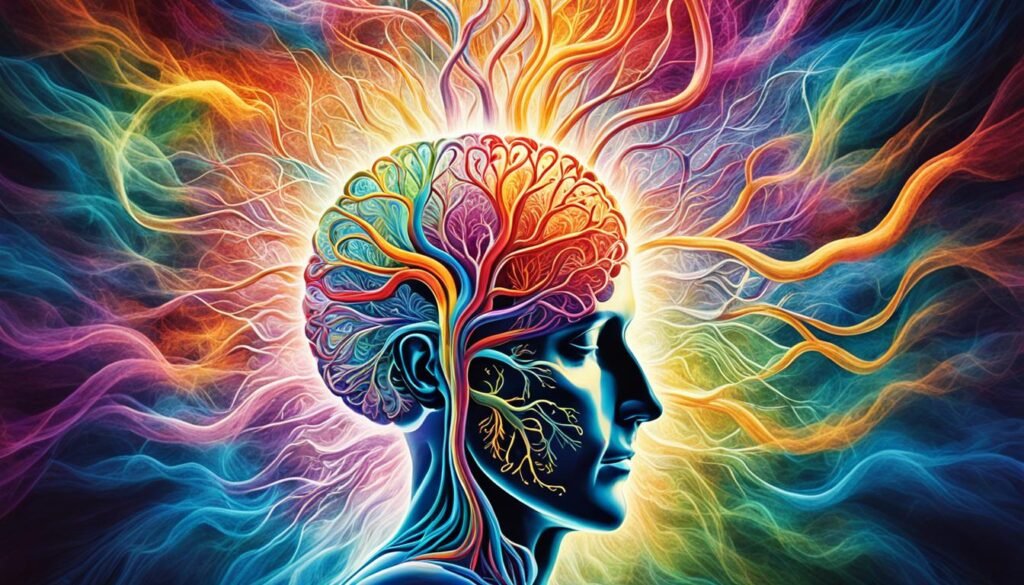
Exploring neurotheology, I’m drawn to its insights on God and the divine from a neuroscientific view. Some think religious experiences are just biological phenomena. Yet, others believe the data doesn’t rule out a divine presence in our world25. Neurotheology should respect both views, knowing brain scans can’t prove or disprove God’s existence.
The Concept of an Uncaused First Cause
The idea of an uncaused first cause is a key argument for God’s existence. It says the universe had a start and needs a reason behind it. Neurotheology helps us understand how our brains handle this idea. It shows us the mental and emotional roots of believing in a divine creator.
Neuroscientific Perspectives on the Divine
Studies show certain brain areas light up during spiritual acts like meditation or prayer26. This doesn’t prove or disprove God’s existence. Instead, it tells us how our brains react to spiritual experiences. It’s a deep dive into the brain’s role in spirituality.
“Science cannot solve the ultimate mystery of nature. And that is because, in the last analysis, we ourselves are a part of the mystery that we are trying to solve.” – Max Planck
As neurotheology looks at the link between neuroscience and theology, we must keep an open mind. Understanding religious or spiritual beliefs can help bridge the gap between science and faith. This gives us a fuller picture of what it means to be human.
| Perspective | Key Points |
|---|---|
| Biological Phenomena | Religious experiences can be explained by brain activity and neurochemical processes. |
| Divine Presence | Neuroscientific data does not eliminate the possibility of a divine presence in the world. |
| Neurotheological Approach | Neurotheology must be open to both perspectives and engage in respectful dialogue. |
My journey in neurotheology and understanding God’s nature makes me think of Albert Einstein’s words: “Science without religion is lame, religion without science is blind.” By combining different fields and staying curious and humble, we can learn more about the divine and our role in the universe.
Neurotheology and Religious Experiences
Neurotheology looks at how our brains connect with religious experiences. It uses science to study mystical experiences, spiritual practices, and sacred rituals. By looking at brain activity, neurotheology tries to link science with spirituality. This helps us understand faith and its effects on our minds.
Dr. Andrew Newberg is a key figure in neurotheology. He’s a professor at Thomas Jefferson University and has written many books on the topic27. He and David Yaden surveyed about 2,000 people to learn more about their spiritual experiences27.
Researchers use brain scans to study religious experiences. For example, Mario Beauregard at the University of Montreal used fMRI on Carmelite nuns. His study showed that religious experiences use many brain areas, not just one special spot28. A 2016 study found that certain Mormon practices activated brain areas linked to pleasure and focus28.
“Neurotheology has the potential to elevate William James’s work to a new level, exploring the impact and benefits of spiritual experiences on the brain.”29
Neurotheology brings up big questions, like if everything about us can be explained by our brains29. People worry about how brain scans might affect our free will and how we see God29.
Despite these issues, neurotheology is making great progress. A 2011 study linked brain changes to deep religious experiences in older adults2827. This shows how our brains can change because of spiritual experiences.
Neurotheology could also help us understand how religion helps us. Studies show that being religious can make us healthier and happier27. By learning more about this, we might find new ways to use spirituality for better mental health.
In conclusion, neurotheology is a fascinating mix of science and spirituality. It helps us understand religious experiences and their effects on our brains. As we keep exploring, we’ll learn more about how faith connects with our minds and overall health.
Future Directions in Neurotheology Research
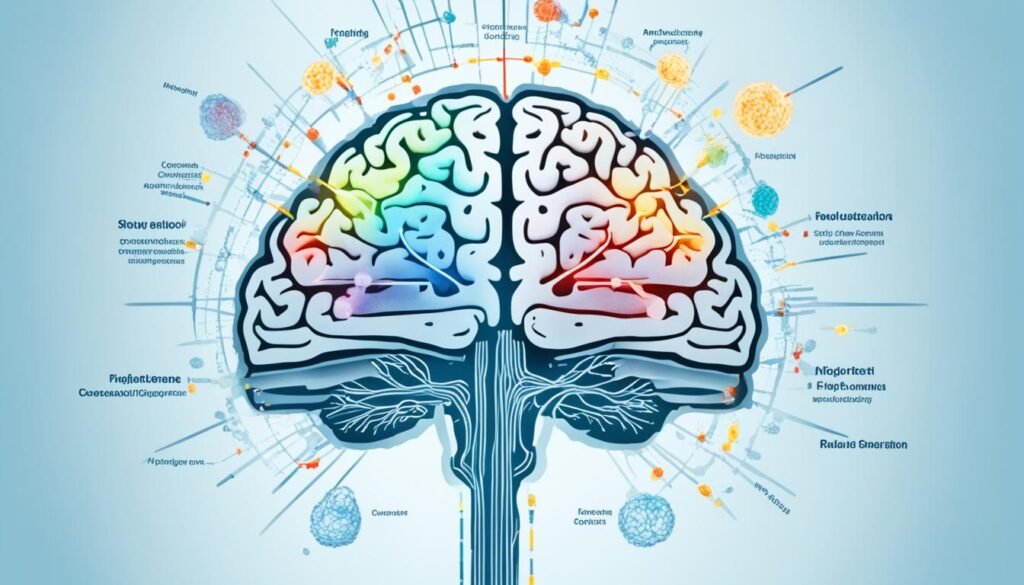
Neurotheology is a new field that combines neuroscience and theology. It has a lot to explore and research30. Andrew Newberg is a leader in this area, showing us the potential to understand how the brain and spirituality connect30.
Defining Key Terms and Concepts
One big challenge in neurotheology is defining complex terms clearly. Researchers need to define terms like mind, consciousness, brain, and spirit for solid research31. They will use statistics to help, focusing on things like study design and the meaning of their findings31.
Studying Long-Term Effects of Religious Practices
Looking at how long-term religious practices affect the brain is another area to explore. By studying people who have practiced prayer or meditation for a long time, we can learn how these activities change the brain. This could show how religion helps mental health and prevents brain disorders.
Neurotheology and Brain Disorders
Studying how religious experiences relate to brain disorders like epilepsy and Parkinson’s disease is key. This helps us understand how the brain and religion interact. It could also lead to new ways to treat these disorders.
Neurotheology can also help us understand consciousness and its link to the brain. Andrew Newberg’s work shows how this question is central to the field31. Exploring topics like artificial intelligence and consciousness is also important31.
Neurotheology is very promising for understanding the brain, spirituality, and consciousness. By defining terms, studying religious practices, and looking at spiritual experiences and brain disorders, researchers can make big advances in this field.
The Potential Impact of Neurotheology
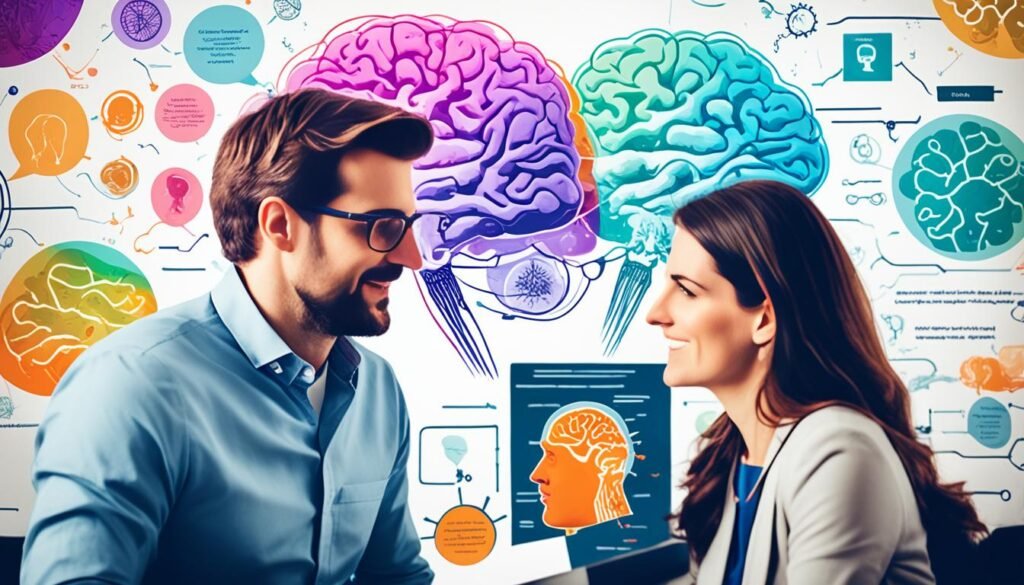
Neurotheology is growing, and its impact on understanding us is big. It brings together neuroscience and theology for a new view. This field could change how we see the link between our brain and spiritual feelings. It might help us understand ourselves better.
Bridging Science and Spirituality
Science and religion often clashed before. A survey showed 64% of scientists don’t believe in God, unlike 6% of people in the U.S32. Yet, 30% of scientists weren’t sure about God’s existence, unlike 4% of others32. Neurotheology could bridge this gap by looking at how our brain handles spiritual feelings. This could lead to a better understanding between science and spirituality.
Implications for Mental Health and Well-Being
Neurotheology could also help with mental health. Studies show religious people often live longer and feel happier27. Practices like meditation have been shown to help with memory and stress27.
A 2011 study found that spiritual experiences could affect the brain, which might improve mental health27. This shows that spiritual activities could change how our brain works, which could make us feel better.
Neurotheology also brings new ideas on big questions like free will. Studies show our brains make decisions before we even realize it27. This could change how we see ourselves and our choices, helping with mental health.
Neurotheology could be key to understanding the brain, spirituality, and mental health better. This could lead to new ways to improve our health and happiness.
As neurotheology grows, it could change how we see ourselves and our spiritual lives. It could help us understand the complex relationship between our brain, spirituality, and mental health. By bringing together different fields, it could lead to better ways to help us all.
Challenges and Criticisms of Neurotheology
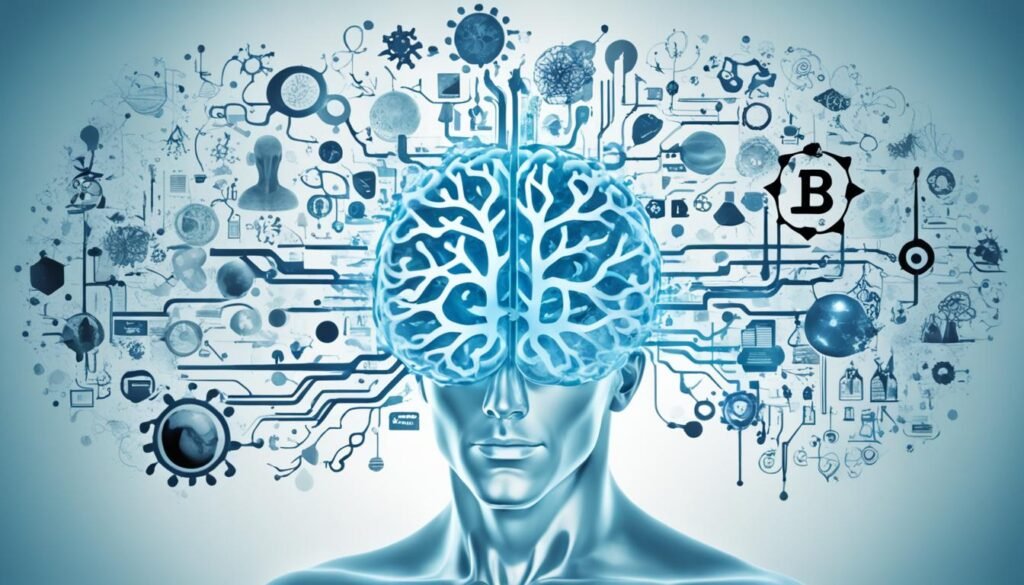
Neurotheology is a new field that faces many challenges and criticisms. It needs to balance scientific study with respect for spirituality and religion33. This field combines theology, religious studies, philosophy, cognitive science, neuroscience, psychology, and anthropology2.
Some critics say neurotheology might turn spiritual experiences into just biology, losing their deep meaning. Others worry it could push certain religious views, losing its scientific focus33. To overcome these issues, neurotheology must be open-minded and unbiased, bringing together different views and studies2.
“Neurotheology faces challenges due to the inaccurate or inappropriate use of the term, often not involving neuroscience and theology as it should.”2
Researchers must be careful not to overstep their findings or go beyond what the data shows. This is crucial because religious and spiritual experiences are sensitive. By using strict science and respecting spiritual traditions, neurotheology can grow and prove its value2.
Another issue is the lack of clear terms for important ideas like consciousness and the soul. This confusion can make research hard to understand and share. To move forward, neurotheology needs to agree on these terms for better communication and teamwork1.
Despite its challenges, neurotheology could greatly improve our understanding of how the brain and religion connect. By looking at this through philosophy, theology, and other sciences, it can shed light on human spirituality and its brain roots33.
- Balancing scientific rigor and spiritual respect
- Avoiding reductionism and promoting interdisciplinary integration
- Developing clear definitions for key terms and concepts
- Interpreting findings cautiously and objectively
As neurotheology grows, it could link science and spirituality, giving us a deeper understanding of being human. By working together, neuroscientists and theologians can help us see religion in a new light21.
The Importance of an Interdisciplinary Approach in Neurotheology
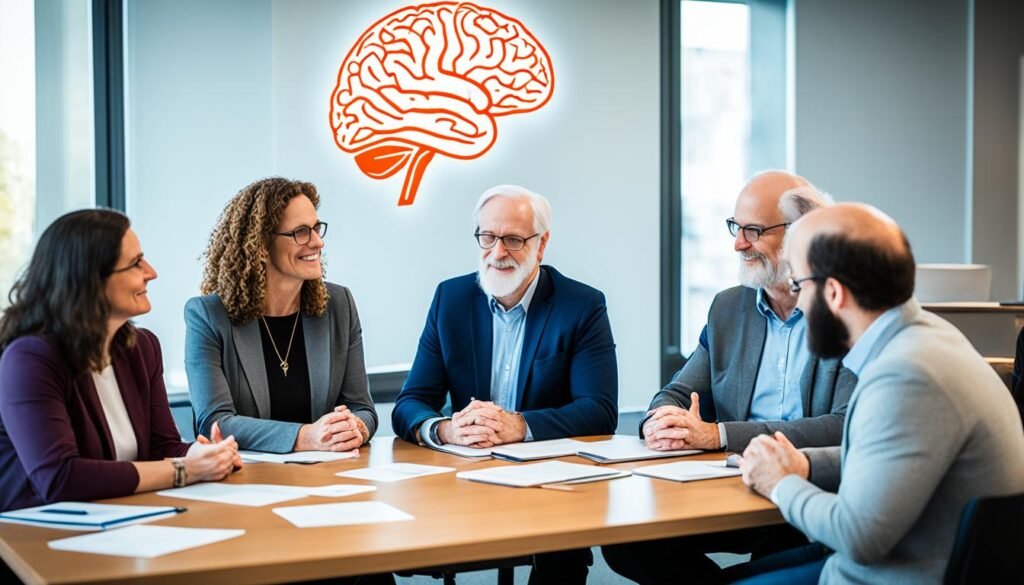
As a neurologist with 20 years in neurotheology34, I see the need for an integrative approach. This field links brain activity to religious experiences. It uses insights from many areas like neuroscience, anthropology, and theology35.
Collaboration Between Neuroscience and Theology
Working together, neuroscientists and theologians make neurotheology a strong field. They review both science and spiritual studies34. This mix helps us understand human history and how spirituality affects us34. Research in this area brings new ways to study the brain and consciousness34.
“Neurotheology is not reductionistic but seeks a common ground between religion and science.”35
Incorporating Other Relevant Fields
Understanding religious practices needs insights from many areas. Studies on spiritual experiences add context to brain data35. Knowing how emotions and sensory experiences work in the brain helps explain spiritual feelings35.
Neurotheology can help people find meaning and purpose by combining science and spirituality34. Working together, researchers from different fields can create new methods. This leads to a deeper understanding of the brain and religion, helping everyone.
Conclusion
Neurotheology is a fascinating field that combines neuroscience and theology. It helps us understand the human experience better. By linking the brain and religious beliefs, it gives us new insights2.
More people around the world are now interested in neurotheology. This shows its importance in our scientific and spiritual lives2. Researchers find that spiritual feelings come from different parts of the brain, not just one special spot36.
Looking into the future, neurotheology will focus on how the brain affects our beliefs2. By studying how we see things, think, and understand cause and effect, we can learn more about religion2. It’s important to keep an open mind when studying this, knowing that many theories are needed37.
Psychology can explain why people believe in religion, but it can’t prove if a supernatural being exists37. Neurotheology is growing, and working together with neuroscience, theology, and other fields is key2. This way, we can understand science and spirituality better.
Through research and open-mindedness, neurotheology can change how we see our minds and religion. Let’s keep exploring this field with respect for all views. For more information, check out the Say Something Theological journal. It has great articles on neuroscience and religion.
FAQ
What is neurotheology?
Neurotheology is a new field that looks at how our brains and religion connect. It aims to understand spiritual experiences and how religion changes our brains.
What are some of the key disciplines involved in neurotheology?
This field combines theology, religious studies, philosophy, cognitive science, neuroscience, psychology, and anthropology. It’s a mix of many disciplines.
Who coined the term “neurotheology”?
Aldous Huxley first used the term “neurotheology” in his 1962 book “Island.” It became more popular in the 1990s with new brain imaging tools.
What brain imaging techniques are used in neurotheology research?
Researchers use SPECT, PET, and fMRI scans to see how the brain works during religious activities. These scans show brain activity during spiritual experiences.
How do religious practices like prayer and meditation affect the brain?
Prayer and meditation touch the brain’s emotional, memory, and experience centers. Regular meditators show more activity in the frontal lobe, which helps with focus.
Can neurotheology shed light on the nature of consciousness?
Yes, it can help us understand consciousness better. By studying the brain during religious experiences, we learn more about the mind and consciousness.
What is the significance of the brain’s causal function in neurotheology?
The brain’s ability to see cause and effect is key in theology. It leads to questions about God as the ultimate cause. This has sparked debates among scholars and scientists.
How can neurotheology contribute to the dialogue between science and spirituality?
It can connect science and spirituality by combining research and spiritual views. This helps us understand human experiences more fully.
What are some of the challenges and criticisms faced by neurotheology?
Neurotheology must balance science with spirituality. Critics worry it might simplify spiritual experiences or push certain religious views.
Why is an interdisciplinary approach important in neurotheology?
Mixing insights from neuroscience, theology, psychology, anthropology, and philosophy is key. It helps us grasp the complex link between the brain and religion better.
